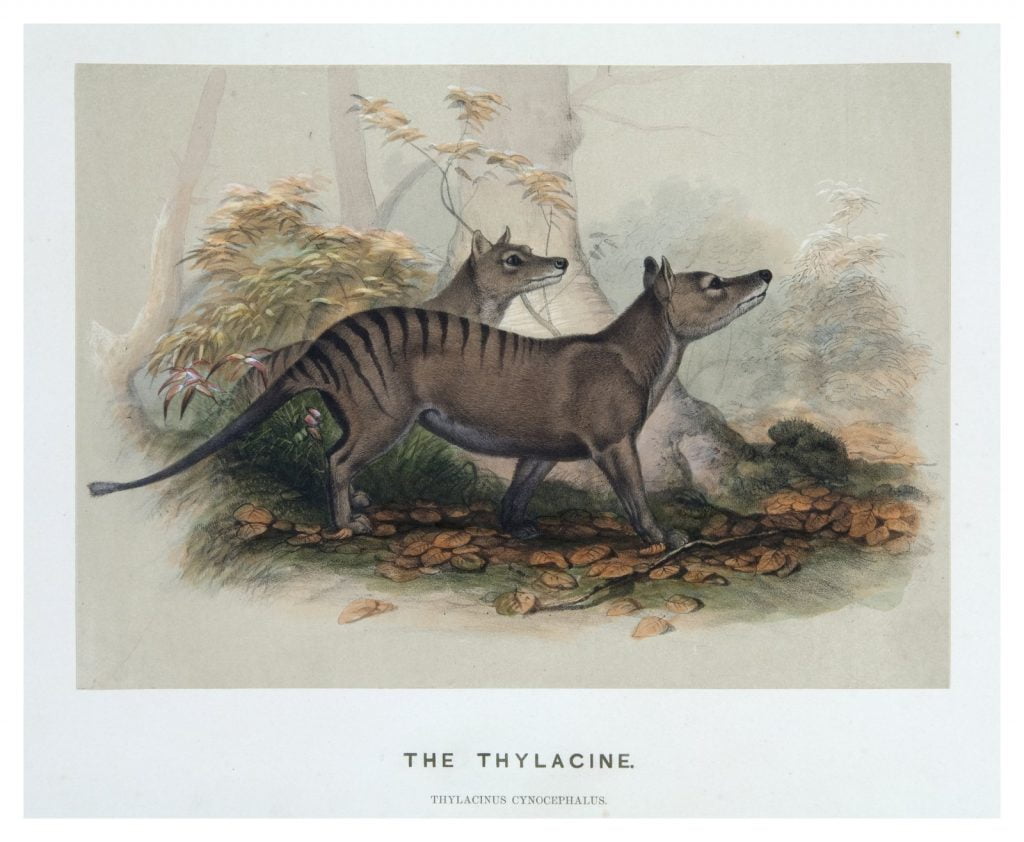The Thylacine IELTS Reading answers and explanation
A new IELTS Reading Academic test passage 1 from Cambridge IELTS 17 Reading test 3 The thylacine IELTS Reading answers with location.
In this IELTS Reading exam, you will find The thylacine IELTS reading answers with location mini-IELTS

In the answer tab, you can find The thylacine IELTS reading answers with location
The Thylacine IELTS Reading passage 1 test
READING PASSAGE 1
You should spend about 20 minutes on Questions 1-13 which are based on Reading Passage 1 below.
The thylacine

The extinct thylacine, also known as the Tasmanian tiger, was a marsupial* that bore a superficial resemblance to a dog. Its most distinguishing feature was the 13-19 dark brown stripes over its back, beginning at the rear of the body and extending onto the tail. The thylacine’s average nose to-tail length for adult males was 162.6 cm, compared to 153.7 cm for females.
The thylacine appeared to occupy most types of terrain except dense rainforest, with open eucalyptus forest thought to be its prime habitat. In terms of feeding, it was exclusively carnivorous, and its stomach was muscular with an ability to distend so that it could eat large amounts of food at one time, probably an adaptation to compensate for long periods when hunting was unsuccessful and food scarce. The thylacine was not a fast runner and probably caught its prey by exhausting it during a long pursuit. During long-distance chases, thylacines were likely to have relied more on scent than any other sense. They emerged to hunt during the evening, night and early morning and tended to retreat to the hills and forest for shelter during the day. Despite the common name ‘tiger’, the thylacine had a shy, nervous temperament. Although mainly nocturnal, it was sighted moving during the day and some individuals were even recorded basking in the sun.
The thylacine had an extended breeding season from winter to spring, with indications that some breeding took place throughout the year. The thylacine, like all marsupials, was tiny and hairless when born. Newborns crawled into the pouch on the belly of their mother, and attached themselves to one of the four teats, remaining there for up to three months. When old enough to leave the pouch, the young stayed in a lair such as a deep rocky cave, well-hidden nest or hollow log, whilst the mother hunted. Approximately 4,000 years ago, the thylacine was widespread throughout New Guinea and most of mainland Australia, as well as the island of Tasmania. The most recent, well-dated occurrence of a thylacine on the mainland is a carbon-dated fossil from Murray Cave in Western Australia, which is around 3,100 years old. Its extinction coincided closely with the arrival of wild dogs called dingoes in Australia and a similar predator in New Guinea. Dingoes never reached Tasmania, and most scientists see this as the main reason for the thylacine’s survival there.
The dramatic decline of the thylacine in Tasmania, which began in the 1830s and continued for a century, is generally attributed to the relentless efforts of sheep farmers and bounty hunters** with shotguns. While this determined campaign undoubtedly played a large part, it is likely that various other factors also contributed to the decline and eventual extinction of the species. These include competition with wild dogs introduced by European settlers, loss of habitat along with the disappearance of prey species, and a distemper-like disease which may also have affected the thylacine.
There was only one successful attempt to breed a thylacine in captivity, at Melbourne Zoo in 1899. This was despite the large numbers that went through some zoos, particularly London Zoo and Tasmania’s Hobart Zoo. The famous naturalist John Gould foresaw the thylacine’s demise when he published his Mammals of Australia between 1848 and 1863, writing, ‘The numbers of this singular animal will speedily diminish, extermination will have its full sway, and it will then, like the wolf of England and Scotland, be recorded as an animal of the past.’
However, there seems to have been little public pressure to preserve the thylacine, nor was much concern expressed by scientists at the decline of this species in the decades that followed. A notable exception was T.T. Flynn, Professor of Biology at the University of Tasmania. In 1914, he was sufficiently concerned about the scarcity of the thylacine to suggest that some should be captured and placed on a small island. But it was not until 1929, with the species on the very edge of extinction, that Tasmania’s Animals and Birds Protection Board passed a motion protecting thylacines only for the month of December, which was thought to be their prime breeding season. The last known wild thylacine to be killed was shot by a farmer in the north-east of Tasmania in 1930, leaving just captive specimens. Official protection of the species by the Tasmanian government was introduced in July 1936, 59 days before the last known individual died in Hobart Zoo on 7th September, 1936.
There have been numerous expeditions and searches for the thylacine over the years, none of which has produced definitive evidence that thylacines still exist. The species was declared extinct by the Tasmanian government in 1986.
Now start to answer “The thylacine” questions. You will have 20 minutes to answer questions 1 to 13.
.You can download answers as a pdf file from here:
The thylacine IELTS reading Answers explanations and location
Please watch this video to see the thylacine Reading answers explanation, location and keywords for this exam
Frist, try to answer questions, and then watch the video
The thylacine IELTS reading Questions
The thylacine IELTS Reading Answers with Explanation
| Questions | Answers |
|---|---|
| 1 | carnivrous |
| 2 | scent |
| 3 | pouch |
| 4 | fossil |
| 5 | habitat |
| 6 | TRUE |
| 7 | FALSE |
| 8 | NOT GIVEN |
| 9 | FALSE |
| 10 | NOT GIVEN |
| 11 | FALSE |
| 12 | TRUE |
| 13 | NOT GIVEN |
The thylacine IELTS Reading Answers Explanations and Locations
Question 1 Explanation
Question: ate an entirely 1……. diet
Answer Location: In terms of feeding, it was exclusively carnivorous,
Key words:
- ate, diet
Comparing the question with the passage, we have:
- The content of the passage indicates that this is a carnivore
- => the answer is “carnivorous”
Correct Answer: carnivorous
Question 2 Explanation
Question: Probably depended mainly on 2…….. when hunting
Answer Location: During long-distance chases, thylacines were likely to have relied more on scent than any other sense
Key words:
- depended mainly on, hunting
Comparing the question with the passage, we have:
- Tasmanian tigers often rely on scent when hunting
- => the answer is “scent”
Correct Answer: scent
Question 3 Explanation
Question: young spent first months of life inside its mother’s 3……….
Answer Location: Newborns crawled into the pouch on the belly of their mother,
Key words:
- young spent first months, inside its mother’s
Comparing the question with the passage, we have:
- The newborn baby will be in the mother’s belly bag
- => the answer is “pouch”
Correct Answer: pouch
Question 4 Explanation
Question: last evidence in mainland Australia is a 3,100-year-old 4………
Answer Location:
The most recent, well-dated occurrence of a thylacine on the mainland is a carbon-dated fossil from Murray Cave in Western Australia, which is around 3,100 years old
Key words:
- last evidence, 100-year-old
Comparing the question with the passage, we have:
- The last evidence of a Tasmanian tiger found on the Australian mainland is about 100 years old
- => the answer is fossil
Correct Answer: fossil
Question 5 Explanation
Question: reduction in 5……… and available sources of food were partly responsible for decline in Tasmania
Answer Location: loss of habitat along with the disappearance of prey species, and a distemper-like disease which may also have affected the thylacine
Key words:
- reduction, partly responsible for decline in Tasmania
Comparing the question with the passage, we have:
- The passage points to habitat loss as one of the causes of the decline in the Tasmanian tiger population
- => the answer is “habitat”
Correct Answer: habitat
Question 6 Explanation
Question: Significant numbers of thylacines were killed by humans from the 1830s onwards. (T/F/Not given)
Answer Location: The dramatic decline of the thylacine in Tasmania, which began in the 1830s and continued for a century, is generally attributed to the relentless efforts of sheep farmers and bounty hunters with shotguns.
Key words:
- numbers of thylacines were killed by humans from the 1830s onwards
Comparing the question with the passage, we have:
- The content of the passage is synonymous with sentence 6
- => the answer is TRUE
Correct Answer: TRUE
Question 7 Explanation
Question: Several thylacines were born in zoos during the late 1800s. (T/F/Not Given)
Answer Location: There was only one successful attempt to breed a thylacine in captivity, at Melbourne Zoo in 1899. This was despite the large numbers that went through some zoos, particularly London Zoo and Tasmania’s Hobart Zoo.
Key words:
- thylacines were born in zoos, late 1800s
Comparing the question with the passage, we have:
- The text gives only one case of successful breeding in 1899
- => the answer is FALSE
Correct Answer: FALSE
Question 8 Explanation
Question: John Gould’s prediction about the thylacine surprised some biologists. (T/F/Not Given)
Answer Location: The famous naturalist John Gould foresaw the thylacine’s demise when he published his Mammals of Australia between 1848 and 1863, writing, ‘The numbers of this singular animal will speedily diminish, extermination will have its full sway, and it will then, like the wolf of England and Scotland, be recorded as an animal of the past.’
Key words:
- John Gould’s,
- prediction,
- thylacine surprised some biologists.
Comparing the question with the passage, we have:
- John Gould’s prediction of Tasmanian species decline, not to mention other scientists
- => the answer is NOT GIVEN
Correct Answer: NOT GIVEN
Question 9 Explanation
Question: In the early 1900s, many scientists became worried about the possible extinction of the thylacine. (T/F/Not Given)
Answer Location: But it was not until 1929, with the species on the very edge of extinction, that Tasmania’s Animals and Birds Protection Board passed a motion protecting thylacines only for the month of December, which was thought to be their prime breeding season.
Key words:
- early 1900s, scientists became worried about the possible extinction of
- the thylacine.
Comparing the question with the passage, we have:
- Text text “But it was not until 1929, when the species was on the brink of extinction, that the Tasmanian Board of Animal and Birds Protection approved a proposal to protect thylacines only in December, believed to be the breeding season. their main.”
- => the answer is FALSE
Correct Answer: FALSE
Question 10 Explanation
Question: T. T. Flynn’s proposal to rehome captive thylacines on an island proved to be impractical. (T/F/Not Given)
Answer Location:
A notable exception was T.T. Flynn, Professor of Biology at the University of Tasmania. In 1914, he was sufficiently concerned about the scarcity of the thylacine to suggest that some should be captured and placed on a small island
Key words:
- T. T. Flynn’s proposal, rehome captive thylacines on an island, impractical
Comparing the question with the passage, we have:
- The passage does not mention whether T.T. Flynn’s solution is possible
- => the answer is NOT GIVEN
Correct Answer: NOT GIVEN
Question 11 Explanation
Question: There were still reasonable numbers of thylacines in existence when a piece of legislation protecting the species during their breeding season was passed. (T/F/Not Given)
Answer Location: The last known wild thylacine to be killed was shot by a farmer in the north-east of Tasmania in 1930, leaving just captive specimens
Key words:
- reasonable numbers of thylacines, existence, during their breeding season was passed
Comparing the question with the passage, we have:
- The content of the passage indicates that after the protection law was passed, in 1930 the last individual was killed.
- => the answer is FALSE
Correct Answer: FALSE
Question 12 Explanation
Question: From 1930 to 1936, the only known living thylacines were all in captivity (T/F/Not Given)
Answer Location: Official protection of the species by the Tasmanian government was introduced in July 1936, 59 days before the last known individual died in Hobart Zoo on 7th September, 1936.
Key words:
- 1930 to 1936, thylacines, in captivity.
Comparing the question with the passage, we have:
- The last individual of the Tasmanian species died on 7 September 1936 at the Hobart . Zoo
- => the answer is TRUE
Correct Answer: TRUE
Question 13 Explanation
Question: Attempts to find living thylacines are now rarely made. (T/F/Not Given)
Answer Location: There have been numerous expeditions and searches for the thylacine over the years, none of which has produced definitive evidence that thylacines still exist. The species was declared extinct by the Tasmanian government in 1986.
Key words:
- find living thylacines, are now rarely made
Comparing the question with the passage, we have:
- The text of the passage states that “search efforts were made to no avail and finally in 1936 the species was declared extinct.” Not to mention finding this species today
- => the answer is NOT GIVEN
Correct Answer: NOT GIVEN



Nice website
5555
good
[email protected]
@[email protected]
[email protected]